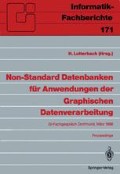Abstract
In the past database management systems have been used predominantly in business applications. A rather new application domain for DBMS are the so called non-standard applications, of which we consider the CAD/CAM applications in the present work. We first describe the basic object classes of a particular CAD/CAM application area, a manufacturing cell. A top down design methodology is presented which supports the hierarchical modeling of a database application. This methodology is applied to conceptually model the manufacturing cell as an Entity-Relationship schema. The ER schema is then transformed into the NF2 data model, a nested relational data model that allows attributes of type relation and list. Special emphasis was put on the preservation of the hierarchical structure of the manufacturing cell within the NF2 schema, thus achieving a very natural model with a high degree of data clustering. A critical evaluation of the NF2 data modeling concepts with respect to engineering applications concludes this work.
Kurzfassung
Während in der Vergangenheit Datenbanksysteme fast ausschließlich in kommerziellen Anwendungen eingesetzt wurden, haben sich in neuerer Zeit die sogenannten Nicht-Standard Anwendungen zu einem eigenen Teilgebiet entwickelt. Als eine dieser Anwendungen betrachten wir in dieser Arbeit den CAD/CAM Bereich. Ziel dieser Betrachtungen ist es, den Ansatz der strukturell objektorientierten Datenmodellierung auf seine Tauglichkeit bezüglich der Darstellung von technischen Objekten zu untersuchen. Die Ausgangsbasis dieser Betrachtungen bilden die Objekte einer Fertigungszelle, die mit Hilfe einer geeigneten top-down Entwurfsmethodik in ein konzeptuelles Modell übertragen wurden. Das hieraus gewonnene E-R-Diagramm wurde in einem nächsten Schritt in ein NF2 Datenmodell transformiert. Dieses nicht normalisierte relationale Datenmodell erlaubt eine einfache Modellierung von hierarchischen Beziehungen mittels geschachtelter Relationen. Bei allen ausgeführten Transformationen wurde insbesondere darauf Wert gelegt, die den Objekten innewohnende Struktur zu erhalten. Nur dieser Ansatz erlaubt dem System zusammengehörige Daten physisch benachbart auf dem Hintergrund Speicher abzulegen, um die Zugriffszeiten zu minimieren. Den Schluß der Arbeit bildet eine Zusammenfassung der gewonnenen Erfahrungen.
Access this chapter
Tax calculation will be finalised at checkout
Purchases are for personal use only
Preview
Unable to display preview. Download preview PDF.
Literatur
Advanced Information Management Prototype User Manual for the online interface of the Heidelberg Data Base Language (HDBL). IBM Scientific Center, Heidelberg, West Germany.
Blume, C. Programmiersprachen für Industrieroboter. Vogel Verlag, 1986.
Balzert, H. Die Entwicklung von Software-Systemen. Bibliographisches Institut, Reihe Informatik, Bd. 34, 1982
Chen, P. The Entity Relationship model: towards a unified view of data. ACM Transactions on Database Systems 1 (1), 9–36, Mar 1976.
Codd, E.F. Extending the Relational Database Model to Capture More Meaning. ACM Transactions on Database Systems 4 (4), 397–434, Dec. 1979.
Date, C.J. An Introduction to Database Systems. Addison-Wesley Publishing Company, 1983.
Dittrich, K.R. Object-oriented database systems: the notion and the issues. Proceedings International Workshop on Object-Oriented Database Systems, Pacific Grove, Ca., Sept 1986, 2–6.
Goos, G. Programmiertechnik. Skriptum zur gleichnamigen Vorlesung an der Universität Karlsruhe, Wintersemester 82/83
Kaltenbach, J. Datenbankzugriffe für wissensbasierte Sensorsysteme in der Robotik. Diplomarbeit an der Universität Karlsruhe, 1987
Kemper, A., Wallrath, M., Lockemann, P.C. Ein Datenbanksystem für Robotikanwendungen. Robotersysteme 2, 177–187, Springer Verlag 1986.
Kemper, A., Wallrath, M. An Analysis of Geometric Modeling in Database Systems. ACM Computing Surveys, Mar 1987
Kemper, A., Wallrath, M. Konzepte zur Integration Abstrakter Datentypen in R2D2- Informatik Fachberichte Nr. 136, S. 344–359, Springer Verlag, April 1987.
Kemper, A., Lockemann, P.C., Wallrath, M. An Object-Oriented Database System for Engineering Applications. ACM SIGMOD Conf. on Management of DATA, 1987
Lockemann, P.C. et al. Anforderungen technischer Anwendungen an Datenbanksysteme. Informatik-Fachberichte, Springer Verlag, Vol. 94, 1–26.
Meier, A. Erweiterung relationaler Datenbanksysteme für ingenieurwissenschaftliche Anwendungen. Springer Verlag, 1987.
Mohrholz, P. Objekt-orientierte Datenbankunterstützung für Robotersimulationen. Diplomarbeit an der Universität Karlsruhe, 1986
Pistor, P., Andersen, F. Designing a generalized NF2 model with an SQL-type language interface. Proc. of the Twelfth Intl. Conference on Very Large Data Base Systems (VLDB), Kyoto, Japan, August 1986, 278–285.
Paul, R. Robot Manipulators. The MIT Press Series in Artificial Intelligence. Cambridge, Massachusetts and London, England, 1981
Rembold, U. Computer Integrated Manufacturing. Chapter 8, Marcel Dekker, 1987.
Schek, H.J., Pistor, P. Data Structures for an Integrated Database Management and Information Retrieval System. Proc. of the Twelfth Intl. Conference on Very Large Data Base Systems (VLDB), Mexico City, 1982.
Teorey, T.J., Fry, J.P. Design of Database Structures. Englewood Cliffs, New York, Prentice Hall, 1982.
Tver, D. F., Bolz, R.W. Robotics Sourcebook and Dictionary. Industrial Press Inc., New York, 1983.
Author information
Authors and Affiliations
Editor information
Editors and Affiliations
Rights and permissions
Copyright information
© 1988 Springer-Verlag Berlin Heidelberg
About this paper
Cite this paper
Dürr, M., Huck, M., Kemper, A., Wallrath, M. (1988). Using an NF2 Data Base System for Modeling of CIM Data. In: Lutterbach, H. (eds) Non-Standard Datenbanken für Anwendungen der Graphischen Datenverarbeitung. Informatik-Fachberichte, vol 171. Springer, Berlin, Heidelberg. https://doi.org/10.1007/978-3-642-73608-7_7
Download citation
DOI: https://doi.org/10.1007/978-3-642-73608-7_7
Publisher Name: Springer, Berlin, Heidelberg
Print ISBN: 978-3-540-19175-9
Online ISBN: 978-3-642-73608-7
eBook Packages: Springer Book Archive

